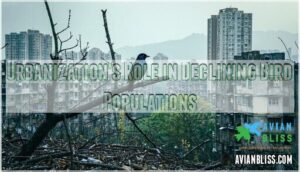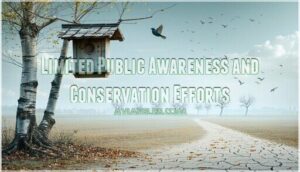This site is supported by our readers. We may earn a commission, at no cost to you, if you purchase through links.

Massive urbanization, industrial pollution, and agricultural expansion create a toxic combination that’s devastating bird populations.
Illegal hunting for food and traditional medicine compounds the problem, while pesticides contaminate their food sources.
Climate change disrupts migration patterns, and invasive species compete for resources.
Air pollution affects their respiratory systems, and light pollution confuses nocturnal species.
Many protected areas are too small or poorly managed to support healthy populations.
The country’s breakneck economic growth has prioritized development over wildlife conservation, leaving birds caught in an environmental squeeze with nowhere to go, due to rapid development and climate change.
Table Of Contents
- Key Takeaways
- Habitat Loss: The Primary Threat to China’s Birds
- Agricultural Intensification and Its Impact on Birds
- Illegal Hunting and Trade of Wild Birds
- Climate Change Effects on Bird Populations
- Pollution and Its Consequences for Bird Life
- Invasive Species Threatening Native Bird Populations
- Insufficient Protected Areas for Bird Conservation
- Urbanization’s Role in Declining Bird Populations
- Limited Public Awareness and Conservation Efforts
- Frequently Asked Questions (FAQs)
- Why are there fewer birds in China?
- Why are wild bird populations declining in China?
- Does China have a wild bird population?
- What are the most common threats to birds in China?
- Why are some birds endangered in China?
- How does China’s industrialization affect birds?
- Why are there not many birds in China?
- Does China have wild birds?
- What happened to birds in China?
- Why did China get rid of birds?
- Conclusion
Key Takeaways
- You’re witnessing habitat destruction on a massive scale – China’s rapid urbanization and agricultural expansion have destroyed over 60% of natural bird habitats, eliminating critical nesting sites and forcing species toward extinction.
- You’ll find pollution creating toxic environments for birds – Industrial chemicals contaminate water sources and food chains, while air pollution damages respiratory systems and pesticides eliminate the insects birds depend on for survival.
- You can’t ignore the impact of illegal hunting and trade – Over 2 million birds were captured illegally between 2014-2020, with poachers targeting species for food, traditional medicine, and the pet trade despite protection laws.
- You’re seeing climate change disrupt ancient migration patterns – Rising temperatures force birds to alter breeding seasons and relocate to new territories, while extreme weather events destroy habitats faster than birds can adapt.
Habitat Loss: The Primary Threat to China’s Birds
China’s once-thriving bird populations face devastating habitat destruction as rapid urbanization and development consume millions of acres of natural ecosystems annually.
You’ll discover that deforestation, wetland drainage, and infrastructure expansion have eliminated critical breeding grounds, forcing countless species toward extinction.
China’s birds vanish as concrete replaces forests, wetlands become farmland, and development devours their homes.
While fragmenting remaining habitats into isolated patches too small to sustain viable populations.
Urbanization and Infrastructure Development
China’s urban sprawl creates a concrete jungle where wild birds china once thrived.
You’re witnessing infrastructure growth that transforms natural habitats into highways and high-rises.
City expansion fragments ecosystems, while development impacts include noise pollution and artificial lighting that disrupts bird behavior.
Urban planning rarely prioritizes wildlife corridors, leaving birds homeless.
This urbanization process accelerates habitat loss faster than conservation efforts can compensate, making habitat destruction a primary threat to avian populations.
Deforestation and Land Use Changes
You’ll witness forest clearance destroying bird homes at alarming rates across China.
Deforestation eliminates critical nesting sites, while land use changes fragment ecosystems into unusable patches.
Agricultural intensification converts forests into monoculture farms, causing severe habitat loss.
Soil erosion follows logging operations, creating land degradation that prevents forest recovery.
This ecosystem loss leaves species like the Chinese Monal without shelter or food sources.
The main driver of this issue is the significant habitat loss effects on local bird populations.
Wetland Drainage and Coastal Reclamation
Several factors drive wetland loss and coastal reclamation across China, creating devastating habitat loss for migratory birds.
These development pressures transform critical ecosystems into urban and agricultural spaces, causing ecosystem disruption on massive scales.
- Wetland drainage converts marshes into farmland, eliminating feeding grounds for species like the Siberian crane
- Coastal reclamation projects create new land but destroy tidal flats essential for shorebirds
- Water pollution from industrial runoff degrades remaining wetland quality, affecting food chains
- Habitat fragmentation isolates bird populations, reducing breeding success and genetic diversity
- Wild bird decline accelerates as pollution effects compound with shrinking suitable habitats
Impact on Breeding and Nesting Sites
Beyond the obvious wetland losses, habitat destruction eliminates critical breeding colonies where birds establish their nesting sites.
When construction crews clear forests and grasslands, they’re destroying carefully chosen locations that took generations to establish.
Site destruction directly impacts breeding habits, forcing birds to relocate during sensitive reproductive periods.
Habitat fragmentation isolates remaining nesting areas, reducing egg survival rates and increasing chick mortality.
Poor nesting success creates population bottlenecks that ripple through entire ecosystems.
Agricultural Intensification and Its Impact on Birds
You’ll find that China’s push for maximum crop yields has created vast agricultural deserts where birds once thrived.
Modern farming practices have replaced diverse ecosystems with chemical-dependent monocultures that offer little food or shelter for wildlife.
Monoculture Farming and Reduced Biodiversity
You’ll find monoculture farming creates biological deserts where diverse bird species once thrived.
These vast single-crop fields eliminate the crop diversity that supports different feeding and nesting requirements.
Traditional farm practices provided varied ecosystem services, but agricultural intensification removes hedgerows, mixed plantings, and fallow areas.
This biodiversity loss forces species like the Chinese Monal to abandon former territories, as agroecology principles get replaced by industrial efficiency.
The adoption of organic farm products can help mitigate the effects of monoculture farming on local ecosystems.
Pesticide and Fertilizer Use
Intensive crop management with pesticides and fertilizers creates a deadly landscape for China’s wild birds.
Toxic chemicals accumulate in bird tissues, while fertilizer pollution contaminates water sources.
Pesticide residues kill insects that birds depend on for food, and agricultural intensification spreads soil contamination across vast areas.
This environmental degradation forces species like the Chinese Monal to abandon traditional feeding grounds entirely, leading to a significant impact on the ecosystem and wild birds.
Loss of Traditional Farming Practices
Traditional farming practices supported crop diversity and natural ecosystem services, creating bird-friendly environments.
Modern agricultural intensification eliminates these methods, replacing traditional farming practices with monoculture systems.
You’ll find fewer hedgerows, diverse plantings, and natural pest predators that birds relied upon. Soil health deteriorates without crop rotation, reducing insect populations that feed birds.
Farming techniques now prioritize efficiency over biodiversity, converting bird habitats into sterile farm land use patterns that can’t sustain wildlife populations.
The loss of natural habitats is often caused by habitat loss effects that disrupt ecosystems and lead to population decline.
Conversion of Natural Habitats to Farmland
China’s farmland expansion destroys critical bird habitats at an alarming rate, with natural ecosystems vanishing under agricultural pressure.
This habitat loss forces species like the Chinese Monal into smaller, fragmented territories.
Here’s how farmland expansion devastates bird populations:
- Wetlands drained for rice cultivation eliminate waterfowl nesting sites
- Forest clearance for orchards removes canopy-dwelling species’ homes
- Grassland conversion to cropland destroys ground-nesting bird territories
- Monoculture farming creates habitat fragments unsuitable for diverse species
This ecosystem loss represents one of agriculture’s most damaging impacts on China’s avian biodiversity.
Illegal Hunting and Trade of Wild Birds
You mightn’t realize it, but illegal hunting and trade have devastated China’s wild bird populations over the past several decades.
The combination of poaching for traditional medicine, capturing birds for the pet market, weak law enforcement, and cultural demand creates a perfect storm that continues to reduce avian biodiversity across the country.
Poaching for Food and Traditional Medicine
Wildlife Poaching devastates China’s bird populations through systematic targeting for food and medicinal hunting.
Between 2014-2020, illegal hunters captured over 2.05 million birds across 319 cities, representing 65% of all poached animals.
Over 2 million birds captured illegally—China’s wildlife vanishing at an alarming rate.
Food demand drives this species exploitation, with rare birds fetching 3,000-5,000 yuan in markets. Traditional medicine creates additional pressure, as bird parts treat perceived ailments.
The bird trade affects 32% of China’s species, including endangered taxa. Commercial operations concentrate in eastern and central regions, where enforcement remains challenging despite recent bans on consumption.
The main driver of this issue is the wildlife hunting problem that threatens biodiversity.
Capture for The Pet Trade
Beyond traditional medicine, you’ll find China’s illegal pet trade targeting colorful songbirds and rare species.
Bird smuggling operations capture thousands of wild birds annually, feeding Wildlife Markets that sell Exotic Pets to collectors.
This illegal pet trade disrupts breeding populations while Captive Breeding programs can’t replace wild genetic diversity, leaving ecosystems vulnerable to significant harm from the loss of wild birds.
Lack of Enforcement of Wildlife Protection Laws
Imagine this scenario: you’ve witnessed pet trade captures, but here’s what makes it worse—wildlife protection laws exist on paper yet fail in practice.
Enforcement agencies lack resources, creating regulatory gaps that poachers exploit daily. When penalties are minimal and corruption persists, illegal wildlife trade flourishes unchecked.
- Legal loopholes allow hunters to claim "traditional use" exemptions for protected species
- Insufficient funding leaves conservation officers patrolling vast territories with skeleton crews
- Weak penalties make fines cheaper than potential profits from rare bird sales
- Corruption issues enable some officials to accept bribes, turning blind eyes to violations
- Poor coordination between agencies creates jurisdictional confusion, letting criminals slip through cracks
Cultural Practices Driving Demand
China’s cultural beliefs run deep, creating persistent demand for chinese bird species despite illegal trade restrictions.
The demand is driven by various factors, including traditional medicine practitioners who seek bird parts for remedies, while food culture treats rare birds as delicacies.
The pet trade thrives as songbirds symbolize status and prosperity, and these ingrained practices, passed through generations like family recipes, fuel continuous pressure on bird habitats.
Effective demand reduction requires respecting cultural heritage while promoting alternatives that protect wildlife populations.
Climate Change Effects on Bird Populations
You’ll find that climate change has become one of the most disruptive forces affecting China’s bird populations, altering everything from ancient migration routes to breeding cycles that evolved over thousands of years.
Rising temperatures and shifting weather patterns force birds to adapt quickly or face population decline, with many species struggling to keep pace with rapidly changing environmental conditions, particularly in terms of population decline.
Altered Migration Patterns
While illegal hunting decimates bird populations, climate change creates Migration Disruption through altered pathways and timing.
Birds now face Breeding Delays as seasonal cues shift unpredictably.
Temperature changes force Habitat Shifts, pushing species into unfamiliar territories.
This Climate Chaos confuses navigation systems that evolved over millennia.
Bird Tracking data reveals these troubling patterns:
- Traditional routes become death traps due to extreme weather
- Food sources disappear before birds arrive at stopover sites
- Energy reserves deplete faster on longer, rerouted journeys
- Breeding grounds become unsuitable as temperatures rise rapidly
- Competition intensifies at remaining viable habitats
Climate change basically rewrites the ancient GPS systems birds rely on, leaving them lost in an increasingly hostile world.
Changes in Breeding Seasons and Timing
Climate change disrupts bird populations through breeding disruptions and timing alterations.
Warmer temperatures trigger earlier nesting, but food sources haven’t adapted. This creates reproductive failures when chicks face starvation.
| Breeding Pattern Changes | Impact on Bird Populations |
|---|---|
| Earlier spring nesting (5-10 days) | 17% reduction in chick survival |
| Shortened breeding seasons (12 days) | Lower reproductive output |
| Increased nest failures (23-30%) | Population decline acceleration |
These seasonal changes force migration shifts, leaving birds struggling with habitat loss and climate change consequences.
Shifts in Species Distribution
Rising temperatures push birds to relocate across China’s landscape, creating dramatic shifts in species distribution.
Climate-driven habitat disruption forces species relocation as birds chase ideal living conditions.
You’ll find three major migration patterns emerging:
- Northward movement: Species advance toward cooler latitudes to escape warming temperatures
- Elevation gains: Mountain slopes become refuges as lowland birds seek higher altitudes
- Range contractions: Some populations shrink into smaller suitable habitats
These climate shifts reshape bird populations fundamentally.
Traditional ranges vanish while new territories emerge, causing significant biodiversity loss in formerly bird-rich regions across China’s changing ecosystems.
Extreme Weather Events and Habitat Destruction
Weather extremes are hammering China’s bird populations with devastating force.
Storm surges and coastal erosion destroy nesting colonies, while sea level rise permanently floods critical wetlands.
These climate shifts bring unprecedented challenges – droughts eliminate water sources, floods wash away breeding grounds, and heatwaves push species beyond their survival limits.
Weather extremes create a domino effect of habitat destruction that’s accelerating across the country.
Typhoons demolish forest canopies where songbirds nest, while severe storms fragment remaining bird habitats into isolated patches too small to sustain viable populations long-term, leading to a loss of biodiversity.
Pollution and Its Consequences for Bird Life
You’re witnessing one of pollution’s most devastating impacts on China’s wildlife—contaminated air, water, and soil are systematically destroying bird populations across the country.
From respiratory damage caused by toxic emissions to poisoned food sources from chemical runoff, pollution creates a hostile environment where birds simply can’t survive or reproduce successfully.
Air Pollution and Respiratory Issues
While China’s Air Quality continues deteriorating, wild birds face severe Respiratory Damage from Toxic Emissions throughout industrial regions.
Pollutant Effects compromise their delicate respiratory systems, causing widespread Lung Disease among populations.
Air pollution creates three critical problems for birds:
- Particulate matter clogs their efficient respiratory systems
- Chemical toxins weaken immune responses against diseases
- Smog reduces visibility, disrupting feeding and mating behaviors, leading to severe Toxic Emissions.
Water Pollution and Contaminated Food Sources
Industrial runoff transforms China’s waterways into death traps for avian life.
Agricultural chemicals and factory waste create toxic algae blooms that suffocate aquatic ecosystems. Birds consuming contaminated fish face immediate poisoning, while polluted wetlands spread waterborne diseases through entire populations, causing widespread bird population decline.
Effective water purification systems using advanced water cleaning solutions can help mitigate these issues.
| Pollution Source | Impact on Birds |
|---|---|
| Chemical Runoff | Organ failure, reproductive issues |
| Toxic Algae | Oxygen depletion, habitat loss |
| Contaminated Fish | Direct poisoning, weakened immunity |
| Polluted Wetlands | Disease transmission, nest abandonment |
Plastic Pollution and Ingestion
While water contamination wreaks havoc, plastic pollution poses another deadly threat.
China’s wild birds face widespread plastic ingestion, with over 70% of wetlands containing significant debris.
Birds mistake colorful fragments for food, leading to devastating consequences:
- Plastic Ingestion blocks digestive systems, causing starvation and internal injuries
- Microplastics reduce body mass by 15% in nestlings, weakening survival rates
- Toxic Effects from chemical additives disrupt hormone levels and immune function
- Sea Pollution spreads inland, contaminating feeding grounds with harmful particles
This invisible killer transforms every meal into potential disaster for China’s struggling bird populations.
Light Pollution Affecting Nocturnal Species
Artificial lighting transforms China’s night landscape, disrupting nocturnal species through circadian rhythm interference.
Urban glow confuses bird migration patterns, causing disorientation during seasonal journeys. Light intensity affects foraging behaviors, with owls struggling to locate prey effectively.
Many species face breeding disruption when exposed to constant illumination, contributing to population declines across affected regions.
| Light Source | Impact on Birds | Affected Species |
|---|---|---|
| Street Lighting | Navigation disruption | Migrating songbirds |
| Building Illumination | Collision incidents | Owls, nightjars |
| Industrial Facilities | Breeding interference | Nocturnal hunters |
| Urban Sprawl | Habitat fragmentation | Ground-nesting birds |
Nocturnal disruption extends beyond individual behavior changes, potentially accelerating species extinction rates in heavily illuminated areas throughout China’s expanding cities.
Invasive Species Threatening Native Bird Populations
You might be surprised to learn that invasive species pose a serious threat to China’s native bird populations through direct competition and ecosystem disruption.
These non-native animals and plants don’t just compete for resources—they actively change habitats in ways that make survival difficult for birds that evolved in China’s natural environments.
Predation on Native Birds
Native Bird Predators from invasive species are wreaking havoc across China’s ecosystems.
These foreign troublemakers directly hunt native birds, raid nests, and destroy eggs before they hatch.
Invasive Species like European starlings and house sparrows outcompete locals for Bird Nesting sites and food sources.
Without effective Predator Control measures, China’s endangered birds face mounting pressure from these aggressive invaders, making bird conservation efforts increasingly challenging.
Spread of Diseases
Over recent decades, invasive species have become silent disease carriers, spreading deadly pathogens through China’s bird populations.
These foreign visitors introduce avian influenza strains that native birds lack immunity against, creating perfect conditions for viral outbreaks.
Here’s how disease transmission devastates local populations:
- Avian flu spreads rapidly through crowded wetlands where native and invasive species mix
- Bacterial infections follow viral outbreaks, causing secondary mortality waves
- Parasitic infections weaken birds’ immune systems, making them vulnerable to other diseases
- Cross-species transmission allows pathogens to jump between invasive and native bird populations
Common mynas and other invasive birds act as living reservoirs, carrying Newcastle disease and avian pox into previously unaffected regions.
Understanding non contagious bird diseases is essential to addressing the decline of wild bird populations in China.
Habitat Alteration by Invasive Plants
Invasive plant species create ecological chaos, transforming bird habitats beyond recognition.
When foreign plants establish dominance, they disrupt native ecosystems and trigger widespread habitat destruction.
These botanical invaders alter food sources, nesting materials, and shelter options that birds depend on for survival.
| Invasive Plant | Habitat Impact | Bird Species Affected |
|---|---|---|
| Purple Loosestrife | Wetland drainage | Migratory waterfowl |
| Japanese Knotweed | Riverbank erosion | Stream-dwelling birds |
| Giant Hogweed | Forest understory loss | Ground-nesting species |
| Autumn Olive | Berry competition | Fruit-eating songbirds |
| Kudzu Vine | Tree canopy smothering | Cavity-nesting birds |
Plant encroachment creates habitat disruption that forces birds to relocate or face starvation, contributing to China’s declining bird populations.
Insufficient Protected Areas for Bird Conservation
You might be surprised to learn that China’s protected areas cover only about 15% of the country’s total land area, leaving vast stretches of critical bird habitat unprotected from development and human activities.
Even worse, many existing reserves are too small or poorly connected to support viable bird populations, creating isolated patches that can’t sustain the complex migration routes and breeding cycles these species need to survive, which is a critical issue for their survival.
Limited Size and Connectivity of Reserves
How can you protect birds when their homes are scattered like puzzle pieces across a broken landscape?
China’s wildlife reserves face a critical challenge: most protected areas are too small and isolated to support healthy bird populations effectively.
Key issues with current reserve systems:
- Reserve Size limitations prevent large-scale species movement and breeding
- Habitat Fragmentation creates barriers between essential feeding and nesting areas
- Connectivity Conservation fails when corridors between reserves don’t exist
- Landscape Ecology suffers from poor coordination between neighboring protected areas
- Reserve Management struggles with insufficient resources for effective habitat loss prevention
Inadequate Management of Existing Protected Areas
Management failures plague China’s protected areas like weeds choking a garden.
You’ll find wildlife reserves struggling with chronic underfunding, creating gaps in habitat monitoring and conservation efforts.
Staff shortages mean fewer rangers patrolling vast territories, while poor Protected Area Governance leads to inconsistent enforcement strategies.
Consider these critical management deficiencies:
- Insufficient conservation funding for equipment and personnel training
- Weak enforcement strategies against poaching and habitat destruction
- Poor habitat monitoring systems that miss population changes
- Fragmented Reserve Management between competing government agencies
Without proper wildlife protection protocols, these protected areas become paper parks – existing on maps but failing birds when they need sanctuary most.
Lack of Representation of Key Bird Habitats
China’s protected areas miss essential bird habitats like a net with gaping holes.
Habitat fragmentation leaves species stranded without corridors.
Biodiversity hotspots remain unprotected while conservation biology experts identify gaps.
| Habitat Type | Protection Coverage |
|---|---|
| Alpine regions | Less than 9% |
| Coastal wetlands | Under 15% |
| Broadleaf forests | Below 5% |
| Mountain biodiversity | 30% underrepresented |
| Yangtze wetlands | Declining 10% annually |
Without proper bird sanctuaries covering key ecosystems, wild birds can’t access critical breeding grounds.
This scattered approach undermines ecosystem services and threatens China wildlife populations across fragmented landscapes.
Human Encroachment on Protected Lands
Despite existing protected areas, human encroachment threatens China’s bird populations through land grabbing and unauthorized activities.
Border encroachment by local communities creates ongoing habitat fragmentation, while human settlements expand into designated conservation zones.
- Illegal logging operations strip away critical nesting trees that birds depend on for breeding
- Unauthorized farming converts protected wetlands into agricultural plots, destroying feeding grounds
- Tourism pressure disturbs sensitive species during vital migration periods, forcing birds to abandon traditional routes.
These human activities cause pollution through agricultural runoff and accelerate urbanization pressures.
Wetland drainage for development continues despite legal protections, creating a cycle where habitat loss undermines conservation efforts across China’s most important bird sanctuaries.
Urbanization’s Role in Declining Bird Populations
China’s rapid urbanization has transformed vast landscapes into concrete jungles, creating deadly obstacles and eliminating the green spaces birds desperately need to survive.
You’ll find that modern cities fragment natural habitats into isolated patches too small to sustain healthy bird populations, while noise pollution disrupts their ability to communicate and navigate, affecting their overall survival in these fragmented habitats with limited natural habitats.
Collision With Buildings and Structures
Glass facades create deadly traps for migrating birds, causing millions of bird strikes annually.
Window reflections fool birds into thinking they see open sky or vegetation, leading to fatal building collisions.
Urban lighting disrupts nocturnal navigation, while towering structures block traditional flight paths.
These architectural hazards substantially impact bird populations, making wildlife preservation efforts essential for bird conservation in China’s rapidly expanding cities.
Loss of Urban Green Spaces
Urban Planning increasingly prioritizes development over Green Infrastructure, systematically eliminating bird habitats across China’s cities.
As urbanization accelerates, developers convert parks and green spaces into commercial properties, disrupting City Ecosystems that once supported diverse species.
This habitat loss fragments wildlife corridors, forcing birds to compete for shrinking resources, which leaves Urban Biodiversity vulnerable and declining rapidly.
Incorporating bird friendly plants can help mitigate the loss of urban green spaces, supporting Park Conservation efforts.
Noise Pollution and Its Effects on Birds
Acoustic stress from China’s bustling cities creates a sonic pollution crisis for wild birds.
Traffic, construction, and industrial noise exposure disrupts essential bird behaviors across urban habitats. This auditory damage forces birds to compete with decibel levels that mask essential communications and survival instincts.
Here’s how noise pollution devastates bird populations:
- Communication breakdown – Birds can’t hear mating calls or territorial warnings over city din
- Feeding disruption – Constant noise masks sounds of prey, reducing hunting success rates
- Chronic stress response – Elevated cortisol levels from persistent noise weaken immune systems
This bird disruption creates a domino effect throughout urban ecosystems, forcing species to abandon otherwise suitable territories.
Fragmentation of Habitats in Urban Areas
Beyond the cacophony of city sounds, habitat fragmentation creates an even bigger problem for China’s birds.
As urbanization spreads, natural areas get chopped into smaller, disconnected patches. Think of it like breaking a large pizza into tiny slices scattered across different tables.
Birds can’t easily move between these isolated fragments, leading to smaller populations trapped in inadequate spaces. Urban planning rarely considers wildlife bridges or green corridors that could connect these patches.
Without habitat restoration efforts and eco-friendly designs, fragmentation continues destroying bird habitats. These disconnected islands lack sufficient resources for breeding, feeding, and shelter.
The result? Bird populations decline as they struggle to survive in these urban puzzle pieces, facing a significant threat to their survival.
Limited Public Awareness and Conservation Efforts
You might notice fewer birds in your neighborhood because many people simply don’t know how important bird conservation is or what they can do to help.
The lack of public education, combined with limited government funding for research and weak policy enforcement, creates a perfect storm where bird populations continue declining while communities remain unaware of the crisis unfolding around them.
Lack of Education on Bird Conservation
Most people simply don’t understand how their everyday actions impact local bird populations, creating a dangerous knowledge gap in conservation efforts.
Without proper bird literacy, communities can’t recognize declining species or understand protective measures.
This educational void undermines conservation awareness and weakens wildlife protection laws through lack of public support.
Key educational barriers include:
- Limited environmental curriculum in schools covering avian ecology
- Insufficient education outreach programs reaching rural communities
- Weak community engagement in local conservation efforts
- Missing connections between human activities and bird population declines
- Inadequate public awareness campaigns about threatened species
Insufficient Funding for Research and Protection
China’s bird conservation faces a severe funding crisis that’s crippling protection efforts.
Only 3% of national biodiversity funding goes to ornithological studies, while government expenditure on bird monitoring has dropped 27% over the past decade.
These funding gaps mean fewer than 10 large-scale population surveys receive stable financial support annually.
Research grants for avian conservation remain stuck below ¥5 million per project, while over 60% of bird-rich reserves operate on less than ¥1 million yearly.
Without adequate conservation budgets, protection costs can’t be met, leaving wildlife protection laws poorly enforced and research programs understaffed.
Weak Implementation of Conservation Policies
Despite thorough wildlife protection laws, China’s conservation policies suffer from severe implementation gaps.
Policy enforcement remains inconsistent across provinces, with local governments prioritizing economic development over environmental protection.
Bureaucratic inefficiency creates regulatory gaps that undermine conservation funding allocation.
Government accountability mechanisms fail to monitor compliance effectively, allowing habitat loss and pollution to persist unchecked despite existing legal frameworks protecting endangered species, which is a significant conservation issue.
Need for Increased Citizen Science Initiatives
Citizen science transforms everyday people into conservation champions through community engagement and public participation.
When you join bird monitoring programs, you’re contributing essential data collection that scientists desperately need.
Your backyard observations become powerful tools for tracking bird populations across China wildlife habitats.
Citizen research initiatives help identify declining species, monitor migration patterns, and strengthen conservation efforts.
Bird conservation succeeds when communities unite, making every person a guardian of local ecosystems.
Frequently Asked Questions (FAQs)
Why are there fewer birds in China?
Agricultural expansion across Yunnan Province displaced thousands of native songbirds when rice paddies replaced forest habitats.
You’ll find fewer birds due to rapid urbanization destroying nesting sites, pesticide use eliminating insect food sources, and pollution weakening their immune systems throughout China’s industrialized regions, particularly affecting their survival due to pesticide use.
Why are wild bird populations declining in China?
You’re witnessing habitat destruction, pollution, hunting, and climate change hitting China’s birds hard. Rapid urbanization destroys nesting sites while pesticides poison food sources, creating perfect storm conditions for population crashes.
Does China have a wild bird population?
Yes, you’ll find China hosts remarkable wild bird diversity across its vast landscapes, yet populations face serious decline from habitat destruction, pollution, and hunting pressures threatening species survival.
What are the most common threats to birds in China?
You’ll find habitat destruction from urbanization and agriculture poses the biggest threat.
Followed by pollution from industrial waste, illegal hunting for food and traditional medicine.
Climate change disrupting migration patterns, and pesticide use eliminating insect food sources.
Why are some birds endangered in China?
You’ll find birds endangered in China because habitat destruction from urbanization and agriculture eliminates their homes, while pollution weakens their health and hunting pressure reduces breeding populations substantially.
How does China’s industrialization affect birds?
Despite believing China’s economic boom brings prosperity, you’ll discover industrialization devastates bird populations through habitat destruction, toxic pollution, and infrastructure expansion, forcing species relocations while disrupting their essential breeding cycles.
Why are there not many birds in China?
You’ll notice fewer birds in China due to rapid urbanization destroying habitats, pollution harming their health, intensive agriculture reducing food sources, and illegal hunting pressuring populations despite conservation efforts.
Does China have wild birds?
Curiously enough, you’ll discover China hosts over 1,400 wild bird species across diverse habitats.
However, rapid urbanization, pollution, and habitat destruction have dramatically reduced populations in many regions, making birds seem scarce.
What happened to birds in China?
You’ve witnessed decades of habitat destruction, pollution, and hunting pressure that decimated China’s bird populations. Rapid urbanization destroyed nesting sites while pesticides poisoned food sources, creating today’s quiet skies.
Why did China get rid of birds?
Ever wonder what happened to China’s once-thriving bird populations?
You’re looking at decades of rapid industrialization, habitat destruction, pollution, and hunting that devastated avian communities.
Agricultural expansion, urbanization, and pesticide use eliminated critical nesting sites and food sources nationwide, leading to a significant decline in bird populations due to habitat destruction.
Conclusion
China’s avian exodus tells a sobering environmental story.
Understanding why there are so few wild birds in China reveals humanity’s profound impact on ecosystems.
You’ve seen how habitat destruction, pollution, hunting, and climate change create a perfect storm against bird populations.
These interconnected threats demand urgent action through stronger protection laws, habitat restoration, and public awareness campaigns.
Without immediate conservation efforts, China’s skies will grow increasingly silent, making bird recovery nearly impossible for future generations.
- https://en.wikipedia.org/wiki/Hexi_Corridor
- https://www.un.org/en/climatechange
- https://ebird.org/species/chimon1
- https://www.smithsonianmag.com/science-nature/can-birds-tip-us-natural-disasters-180978571/
- https://www.scmp.com/news/china/science/article/3239150/poaching-major-overlooked-threat-biodiversity-china-study-finds


















Offthepink
August 15, 2025 at 05:16 PM
That's a lot of reasons given to avoid saying the obvious problem: Chinese have been ruthlessly catching and eating every bird they can.